Inside: Use these simple memory games with your children to help them build their memory muscles and improve their thinking skills. Visual games, sound games, observational games, emotional memory games, and so much more!
Thanks to the proliferation of research in the field of neuroscience in the past decade, we now know more about the brain and how it works than in previous generations. And the news is good:
– Our brain is malleable and subject to change.
– We can improve our memory (and other cognitive powers) at any time in our life.
– The brain improves the more we challenge it.
What does all this mean?
It means we can do things every day to sharpen our minds and memories. And it can be fun!
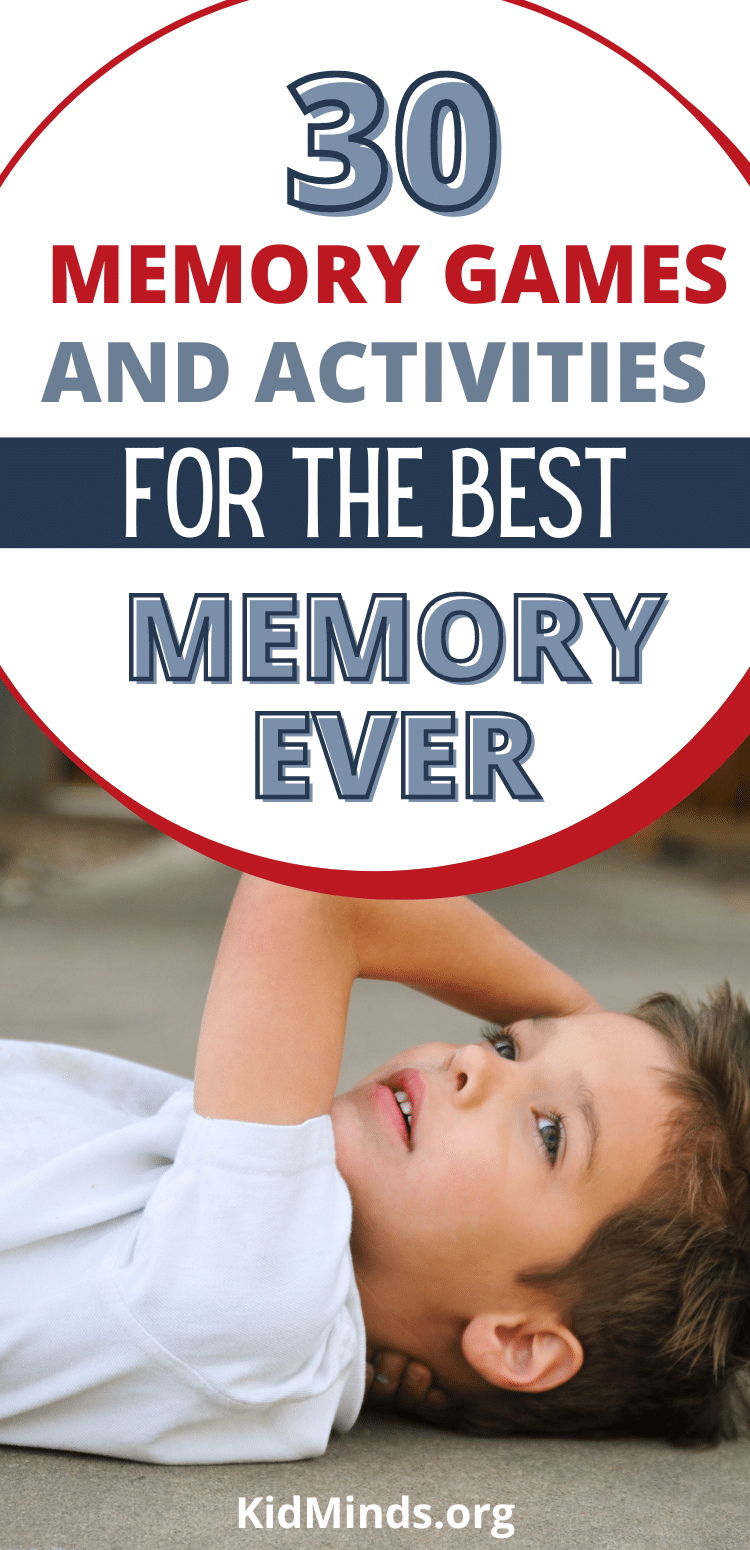
Memory is important to all learning. Everything we know and will ever accomplish depends on our memory, as well as the other components of cognition, like alertness, concentration, mental endurance, problem-solving, creativity, and perceptual speed.
The Lost Tool of Learning
The art of good memory can be viewed as outdated. After all, you can look up everything you need, from the name of the longest river in the world to how to say “where’s the bathroom?” in Sahali.
But did you know that having a good memory can help you in many other, unexpected ways? For example, research shows that good memory helps you focus.
How?
By allowing you to keep your thoughts in order. When you can hold lots of information in your head and manipulate it in your mind effectively, you are in a better position to identify the most relevant and useful items. If you’re sitting in a room full of people, who do you think can problem-solve most efficiently? Probably someone who has the mental capacity to consider multiple angles, remember previous arguments, and mentally synthesize a bunch of data points.
Furthermore, modern research demonstrates that a sharp memory doesn’t just happen. It’s a set of skills that can be learned at any time in our lives. I’m sharing some fabulous activities to help your kids (and you!) sharpen minds and boost mental performance. The games cover episodic memory, sensory memory, visual memory, spatial memory, and much more!
30 Memory Games and Activities We Love
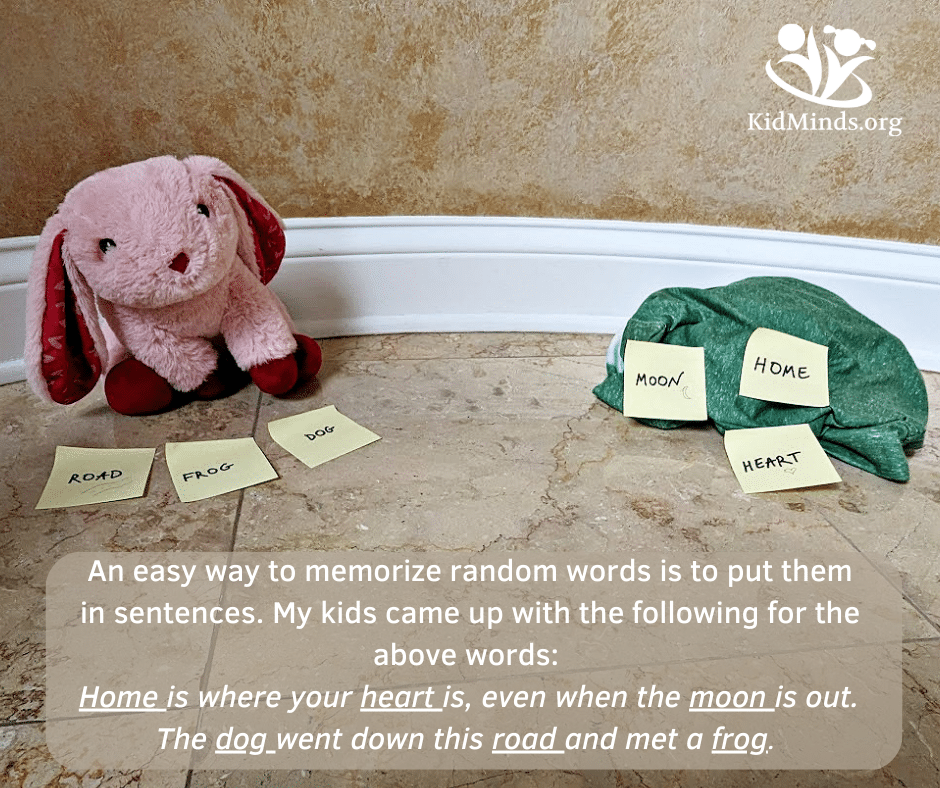
1. Cloud Memory Game
We made this up one day when our flight from Munich to Chicago was delayed. (Was it an 8-hour delay? Well, enough to force us to get creative with entertainment!)
Here’s how you play: grab a pile of cafeteria napkins (or sticky notes) and write down 6-10 common nouns that pop into your head: shark, pen, ice cream, sausage, parrot, car, puppy, moon, etc. One word per napkin.
Designate one area Cloud Bunny (or your child’s favorite stuffed toy), and another area Cloud Green (your child’s favorite color). I’m using “cloud” as an introduction to the powerful chunking technique. Chunking enables us to retain a memory of many seemingly unrelated items simply by forming them into groups.
Hold up each napkin, say the word, and ask your child: Cloud Bunny or Cloud Green? Place the napkin into its proper zone as instructed. Once all the words have a spot, put the words in a sentence.
Now ask your child to recall the word. To make it fun, use hints and associations to help them recall the words. (For the ice cream: sticky and sweet, if you drop it, ants will love it). Increase the number of nouns and the number of clouds as they get better at this game.
Would you believe me if I told you I still remember all 20 words we used the first time we played this game with 20 words? And that was many years ago!
2. Help your Kids Rediscover their Earliest Memories
Start by helping your kids picture their lives as a timeline on a large piece of paper. Start with the year they were born, then add other major life events like moving houses, the birth of siblings, getting pets, starting preschool, etc.
Can you add something to help stimulate their memory? Photographs, keepsakes from their early years, music pieces you played during certain periods of their childhood, bring out some lotions you used in the past, cook the same foods that they ate back then.
When we’re doing this exercise, we’re helping our kids strengthen their episodic memory (it involves the recollection of specific events in the past) as well as an autobiographical memory (which includes episodic and also semantic memory like historical and geographical facts pertaining to one’s history).

3. Blindfold Game for Visual Memory
The ability to remember what we see is important for a number of reasons. We use visual memory to navigate our environment (our town or even a grocery store), to remember people’s faces, and to tackle many academic tasks (from reading to drawing).
This fantastic game has an extra element of challenge that appeals to kids of all ages. Let your kids study simple drawings of animals (we have a printable for this, but you can pick some other objects), then cover their eyes and have them draw what they remember. This game strengthens visual memory, and if you need more instruction, we have a post here: Blindfold Drawing with Kids.

4. Duck, Duck, Goose
I invented this game out of desperation when my toddler was pleading, Play with me, Mommy!, and the idea of another teddy bear tea party was downright painful. I bet you’ll find this version of the classical game appealing on days when you don’t want to move much. 🙂
Invite your kids to arrange their favorite toys in a circle. It can be stuffed animals or Lego pieces of different sizes, colors, and shapes. The more, the better.
Have your child walk (hop or run) around the circle calling out: duck, duck, goose, duck, duck, goose, until they run out of toys. Snap a picture or write down which items are “goose.”
Now scramble all the toys and ask your child to recall which ones were “goose.”
I don’t know what your kids are going to think of this game, but my kids always run around me energetically, laughing their heads off whether they remembered the goose items correctly or not.
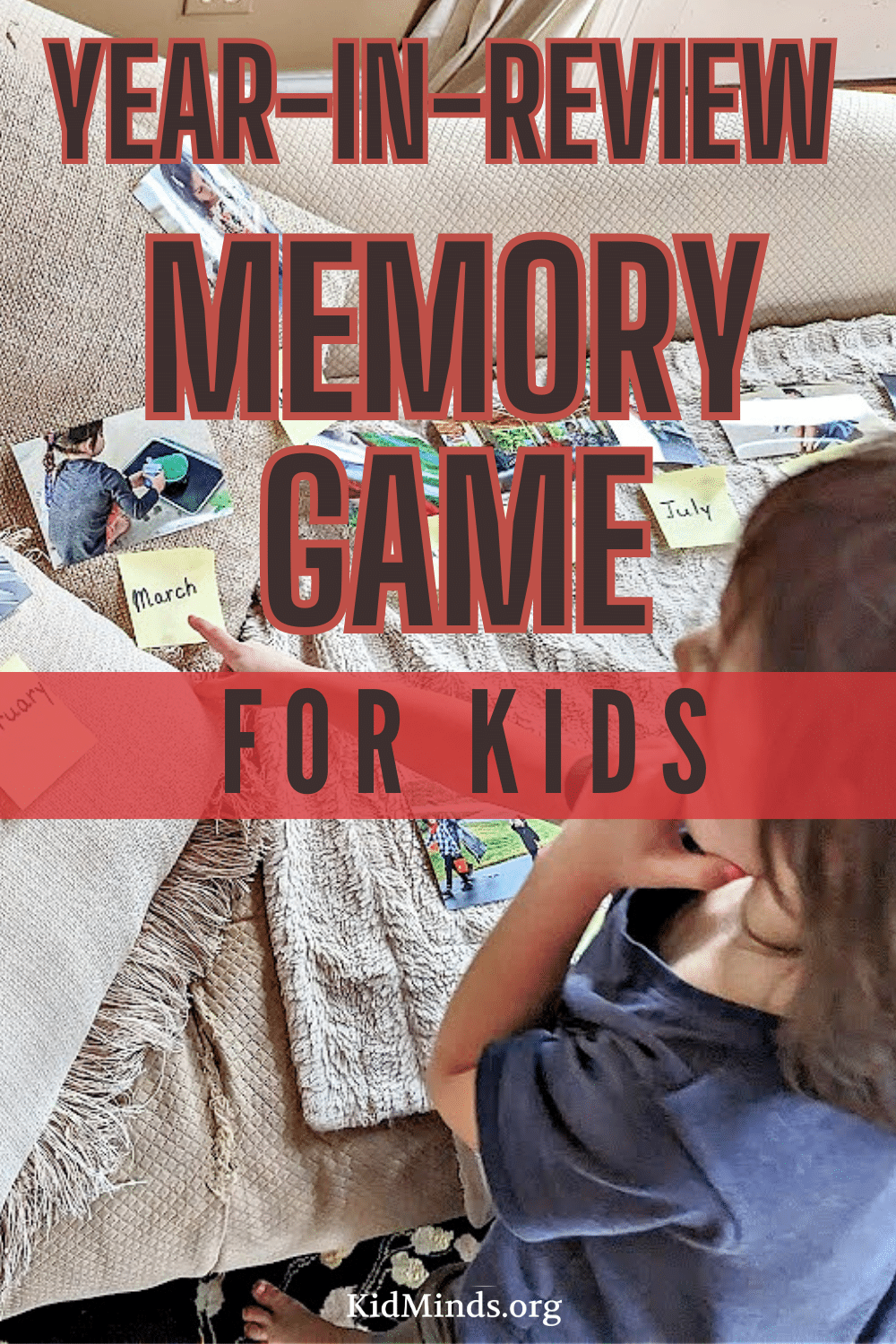
5. Memory Scavenger Hunt and Year-in-Review Game
It’s an irresistible memory game for kids of all ages, but it does require a bit of prep. Look through the photos of your child and pick one for each month of the year. If you play this game around New Year’s Day, it’s a fantastic way to review and talk about the past year.
Print all 12 photos and hide them around the house. While your child is looking, write down the months of the year on 12 pieces of paper.
Once every pic is found, match each photo to the appropriate month and sort them chronologically. Which month was most memorable? Why do they think so? The added advantage here: helping your kids learn a habit of reflection, which is a key to personal growth.
6. Observational Memory Game
When you think about memory, your observational memory might not come to mind unless you’re a huge fan of Sherlock Holmes (like we are). I think we simply don’t spend enough time in our daily life practicing our observational powers. I’ll let Sir Arthur Conan Doyle explain:
Sherlock Holmes, “… you have frequently seen the steps which lead up from the hall to this room.”
Doctor Watson: “Frequently.”
SH: “How often?”
W: “Well, some hundreds of times.”
SH: “Then how many are there?”
W: “How many? I don’t know.”
SH: “Quite so! You have not observed. And yet you have seen.”
So true!! We see, but we do not observe.
Here is how to play this game: Tell kids to observe the objects around them for two minutes, then close their eyes. Ask them to name what they saw based on objects, shapes, and colors in your surroundings.
E.g., name…
- five red items that will fit in their pockets,
- five round things,
- five green rectangle-shaped objects, and
- five blue objects that are too big to fit in a grocery bag.
How did they do? Kids get better fast just by playing this game now and then!

7. Find your Flashlight
To increase our memory power, we need to be better at paying attention. But how to do this in a world full of conflicting thoughts, demands, and loud people? It’s important to realize that our attention is like a beam of light. Focusing is like making a deliberate decision to find a flashlight, switch it on, and direct it at a single thing, thought, emotion, or behavior. Find your flashlight can help train our brain to focus on what or who is important to pay attention to at this moment.
This is how to do it:
Whether you’re driving in a car, walking on a street, or eating a meal, ask your child, Where is your flashlight pointing? This trains your child to pay attention to the internal workings of his or her mind. It’s simple self-awareness training.
Next, if your child is supposed to be doing something he’s not doing, ask, Where does your flashlight need to point? This is a self-monitoring stage. What is the task asking me to do? It’s like pushing the re-engage button.
This game strengthens mental muscles, which makes focusing not only easier but automatic.
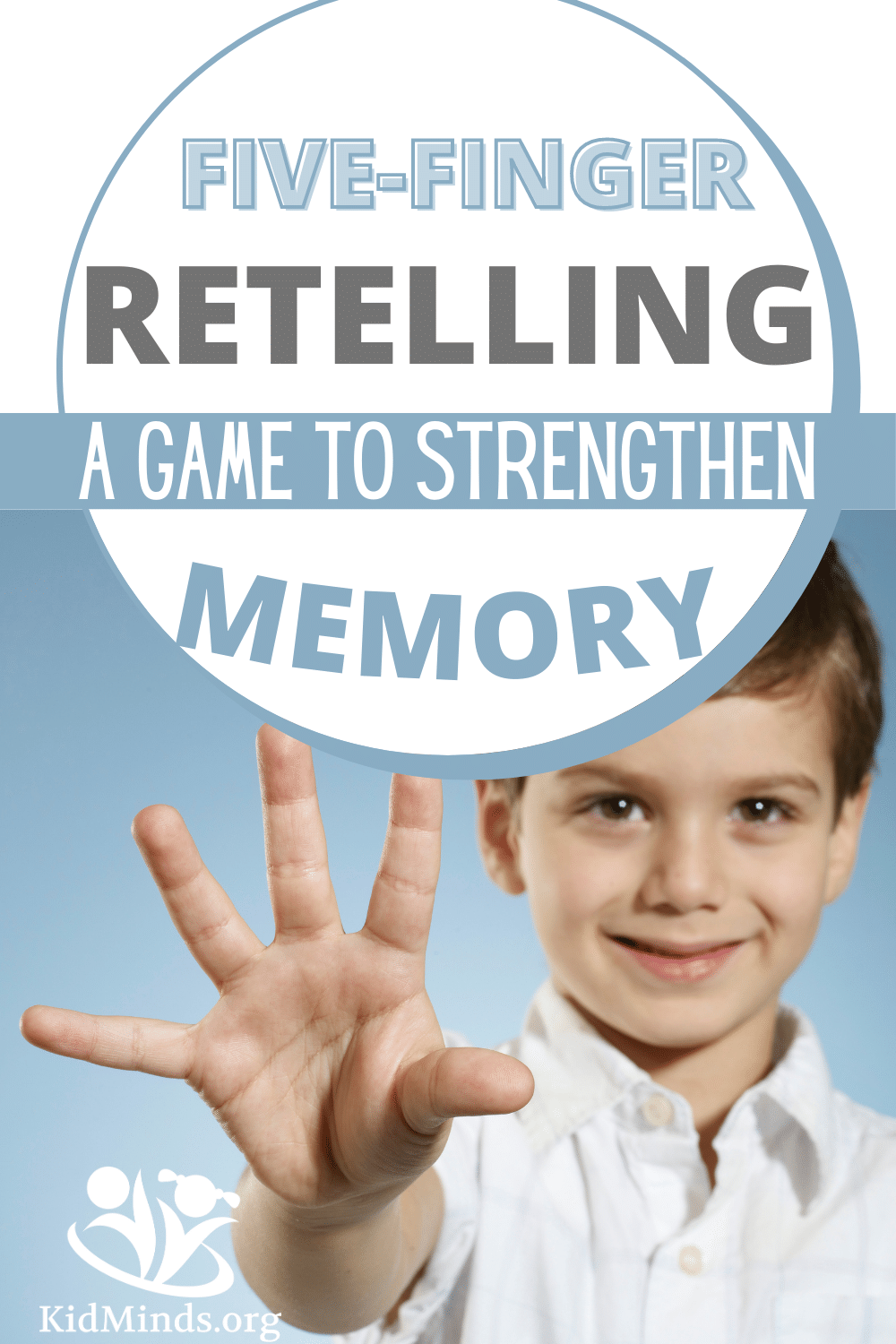
8. Five-Finger Retelling
Encourage kids to recall the details of the story you just read together. It can be a free-flowing retelling when they tell you whatever comes to their minds. Or you can take it a step further by explaining a Five-finger game. It will help kids organize all the plot twists and details of the story and turn it all into a coherent narrative.
How to play this game:
Explain that each finger represents a different aspect of retelling.
Thumb: Who? The characters (the key figures) in the story are…
1st finger: Where? The setting of the story is …
Tall finger: Which? Which problem plucks the main character? What does he/she want that didn’t happen?
Ring finger: What? What happened first? Next? Then? (Conflict/key events)
Little finger: Why? How did it end? (resolution/motives).
Retelling strengthens the brain’s memory centers, hooks the information onto a strong memory template, and makes learning go deeper.
9. Four Corners Game
Here’s another way to practice observational skills. Tell kids to observe a room in your house. Then they’ll close their eyes and walk from one corner to the next until they cover the whole room. We’re doing this very slowly to avoid bruises. How many times did they bump into something? Can they improve by the third or fifth try? If you are going to visit grandma or have a playdate coming up, play this game in a new environment. The more you play, the better you get.
10. Four Details: passive memory exercise
Instruct kids to look at the people around them and memorize 4 details about each—hair color, ear shape, nose size, shoes, nose rings, and clothes. Most of us fail to recall the eye color of the people we see on a regular basis! But being observant allows us to notice patterns, which is a great critical thinking skill. Sometime later, ask the kids to recall the details. That’s the memory part. It’s called passive because it’s only asking you to remember without the use of any elaborate memory techniques. Once you get the hang of the 4 details exercise, you can extend it from people to other things you interact with, like a printer, the wall of the house, or the cover of a book.

11. Remember Your Senses
Sensory memory comes from our five senses: hearing, touch, vision, smell, and taste. Most of us only remember a tiny fraction of the sensory information we are exposed to every day. However, scientists tell us that sensory memory plays an important role in our other memory systems, so it’s good to work on sensory skills when you get a chance.
This scavenger hunt encourages kids to use each of their five senses. It’s a creative and simple way to strengthen sensory memory, which improves your overall ability to take in information and interact with the world around you. Download it from our library of resources. You can get the details by signing up here.
12. Waiting Game
Ask your child to name as many things as he/she can that have holes. Or everything a kid might touch during trick-or-treating. Or what you might find at the library besides books. This game is perfect for when you are standing in line at a grocery store or waiting for your turn at the dentist’s.
13. Memorize a Poem
Memorizing a poem seems so yesteryear, but many studies show that it has lasting and powerful brain-boosting abilities. Why? It’s a brain challenge, yes, but also it builds a framework for other things to hook onto, expands our vocabulary, and builds patterns and connections.
Currently, my kids and I are working through the A Year of Living Poetically Challenge from Mensa for Kids. We love it so much that I decided to go ahead and create our own challenge with our favorite contemporary poems from Jack Prelutsky, Shel Silverstein, and Roald Dahl. You might also get inspired to memorize poems from this popular list.
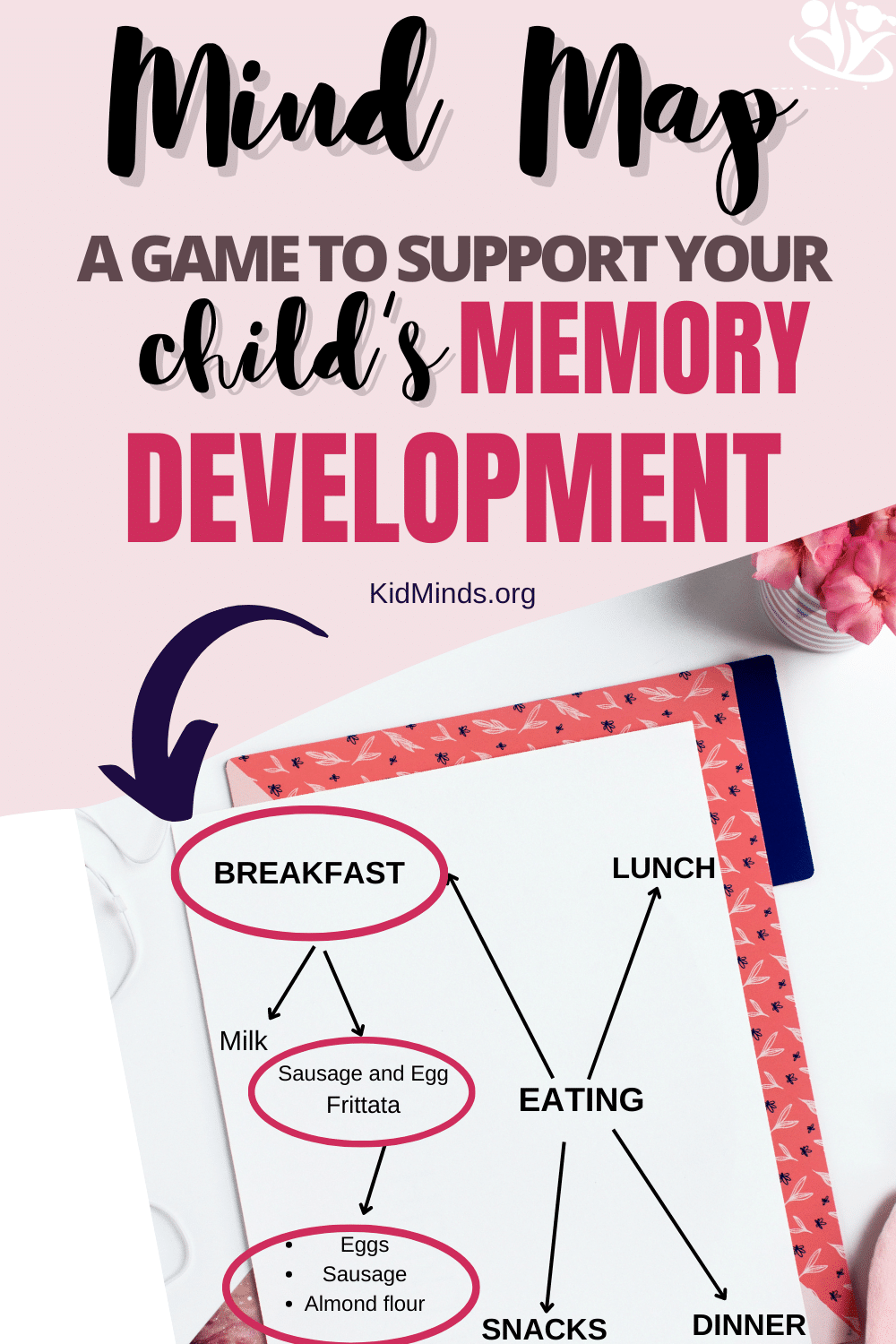
14. Mind Map
When engaging in games that involve visualization, you support your child’s memory development as well as their capacity to think, comprehend and store vast amounts of information. For your first time, do it on paper so that your kids have a clear idea of how to organize the information to remember it better. After that, you can lead them through this mind-mapping game while driving in a car or standing in line.
For example, it’s the end of Tuesday, and you’re driving home after soccer practice. Invite your child to divide the day into various activities and think of a visual image for each. Now concentrate on each image at a time and think of the subdivisions. For example, if one activity is eating, then there might be 3-5 subdivisions for breakfast, lunch, snacks, etc. Your kids might decide to zoom in even further and visualize what they are at each meal, e.g., sausage and eggs frittata for breakfast. You can then help and list each ingredient that went into making the frittata, e.g., eggs, sausage, flour, spices, etc. (It might motivate them to help you the next time you bake a frittata 🙂 Mentally go over the whole day to build the complete mind map.
What things can be grouped together? Which parts of the day relate to each other?
15. Mindfulness Exercise: Tune in to Your Senses
Several research studies indicate that the practice of mindfulness increases the density of the hippocampus, the part of the brain linked to memory.
Here is an easy way to practice mindfulness with kids. Invite kids to look around. What do their eyes see? Are there objects, people, shapes, colors, etc.? What sounds do their ears hear? Which ones of those sounds are near, and which ones are far away? What do their bodies touch? Is it the ground under their feet? Can they feel the bench they are sitting on? The clothes touching the body? Do they smell anything? Is there any taste in their mouth?
Try to play this game at least once every day.

16. Musical Memory Game
Did you know that music not only helps us retrieve things from memory but also helps us to lay down better memories in the first place? According to Harvard Health Publishing, music can open doors to memory vaults. There are lots of music games you can play; here is one to get started.
Turn on Music for Mozart Effect or something like that, and ask your child to lie down with eyes closed and truly tune in. I tell my kids to search for emotions behind the music or visualize a color that goes well with the piece. After you’ve played a few different pieces, go back to the original and see if your kids can recognize it. After a few months of regular listening, you can play a game of Guess what piece is this?
I did this exercise with my oldest 15 years ago, and he still listens to classical music every day. And he always turns it on for his memorization work. He says it helps him concentrate better.
17. The Green and Furry Game
Are kids getting antsy, and the end of the drive is nowhere in sight? Play this game! Take turns remembering/ naming something that is X and Y at the same time (two characteristics of a thing). Look at the examples below to get an idea.
Name something that is:
- Green and furry,
- Slow and shiny,
- Strange and fast,
- Purple and sweet,
- Big and curly,
- Yellow and bumpy.
18. Episodic Recall Game
Remember five things you did last week. Five best picture books you’ve ever read. Remember five things you ate last month. Five best presents you ever got.
Or, with younger kids, simply reflect on something that made them happy in the last 24 hours.
This seems so simple, but you are actually strengthening episodic memory, which refers to the recollection of specific events, situations, and experiences. It’s intensely unique and personal to each individual, and that’s why if you have multiple kids, you already know how remembering a family event brings conflicting recollections from each child. “Aunt Rosie was at my 7th birthday! I remember she gave me a pink elephant!” “No, she wasn’t! She flew from California for MY birthday a month before! I remember because she gave me a pink elephant too.” “Chill out, kids. Aunt Rosie broke her leg that year and didn’t come to anyone’s birthday. She shipped your presents, and everyone got the same elephant!” (True story 🙂
19. Flashcard Magic
A recall is an ability to retrieve information from memory, and flashcards have long been used to make new connections stick. Here is how to practice: take a list you’re working on right now. It might be
- A list of spelling words,
- months of the year,
- states and capitals,
- subordinating conjunctions,
- times tables,
- names of planets in our solar system,
- foreign language vocabulary, or even just
- a random list of words.
Grab a stack of index cards, post-it notes, or simply cut printing paper into squares. On one side, write a word or concept. On the other side, right what you need to know about it. Place the finished cards in the bag or in a pile in front of you. Pick up each card one by one and see if you can get the right answer. If yes, place it in one pile. If not, place it in another pile. When you’re done, take the cards from the second pile and keep going until all of your cards are placed in the I got it right! pile.
Retest your recall in two hours, five, the next day, in a week, etc. If you start this with your kids now, they’ll do this almost automatically for future academic learning.
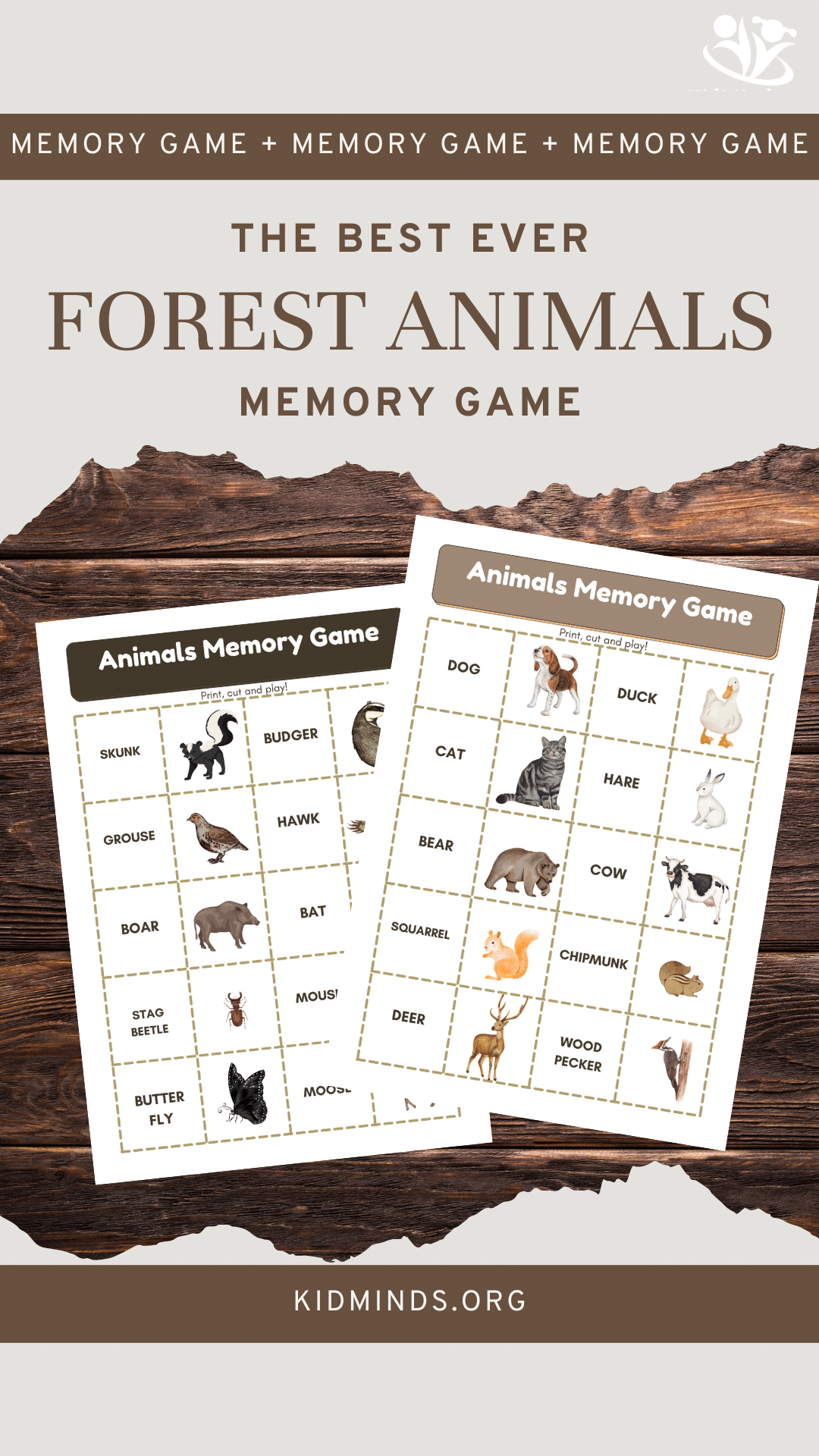
20. Animal Memory Game
I have a great number of memory games on the blog that you can download for free. It’s a classic game, and each different theme gives it a new flavor. One of my daughter’s favorites at the moment is the forest animals game.
Here’s how to play variation A: download the pdf, print each page twice, cut the animal cards ONLY, and place them face down on the floor. Take turns flipping two animal cards over. If the cards don’t match, you put them back in, trying to remember what animals they are and where they are. If the cards match, they are kept away. The game is over when all the animals are matched. The winner is the one with the most pairs of matched cards.
Variation B: everything is the same as above, but you print only one copy of each page because instead of matching a dog card to another dog card, you are matching the pic of the animal to the word that spells its name. This version is more suitable for older kids. You can download our Forest Animals Cards here. Once my email provider gets your info, you will get an automatic message with the direction for downloading the cards from my library of resources.
21. Alphabetical Order
For the young ones, start with the months of the year in alphabetical order. Older kids can try naming all the states in alphabetical order or even reverse alphabetical order. That’s tough enough even for adults, but you’d be surprised how much fun this game can be on a long car ride.
22. Emotional Memory Game (Reinventing Everyday Objects)
Get in the habit of finding creative associations for everyday objects. It will develop your child’s imaginative capabilities in magical ways by expanding the limits of possibilities, stretching their mental muscles, and defying narrow-mindedness.
Here is how to do it:
Tell kids to grab 3 objects that easily come to hand in the room. Say, a book, tape, and a duster. Sit down at the table, spread the objects, and tap into the emotional memory. What emotions come to mind? Afraid, happy, angry, loving, sad, playful, silly, …? Think about the last time you had the same emotion. What colors would convey that emotion? What shapes, lines, and textures can capture that emotion?
Now to the best part! Ask your child to use a non-dominant hand to draw the emotion that came up on the paper. The goal of this emotional memory exercise is to learn to fully feel the current sensations that probably come from things that happened long ago. It’s been said, “Our whole creative experiences are vivid and full in direct proportion to the power, keenness, and exactness of our memory.” In other words, in order to be creative, we have to be able to tap at will into our emotional memory banks.
23. What was there?
Which one is gone? Which one is new? Gather random objects from around your house, your purse, or your classroom. Spread them around, allow kids to look at them for 30 seconds, and cover them up. What was there? Can they name every object?
Now have kids close their eyes and remove one object. Can they name what’s missing? Which one is gone?
You can also add something to the selection and ask, Which one is new?
This game is perfect for practicing observational skills and working memory.
24. Mental Math
Don’t panic! In fact, start with this relaxation technique. Rub the palms of your hands together until they feel warm, then put your warm hands over your eyes. Aahh….
Now, get set, go! How much is 17+17, 7×8, 100-8,… It doesn’t have to be complicated problems. Even simple addition and multiplication problems will get the juices running. The very act of holding the numbers in working memory and manipulating them strengthens memory in many ways. Download our mental math sheets for your next memory training session.
25. We went to the store and bought…
You probably know this game already, but it’s such an easy favorite with most kids. It builds memory, of course, but it’s also alphabet practice.
The first person says, “we went to the store and bought … [something that starts with the letter “A” like “apples”]. Your kid (or whoever is next in line) repeats what you said and adds something that starts with the letter “B.” For example, we went to the store and bought apples and bananas.”
As you all get better at this, you can start adding more sophisticated nouns and adjectives, i.e., affordable apples and beautiful beans.
Another variation of this game is We’re going to a picnic and brought…
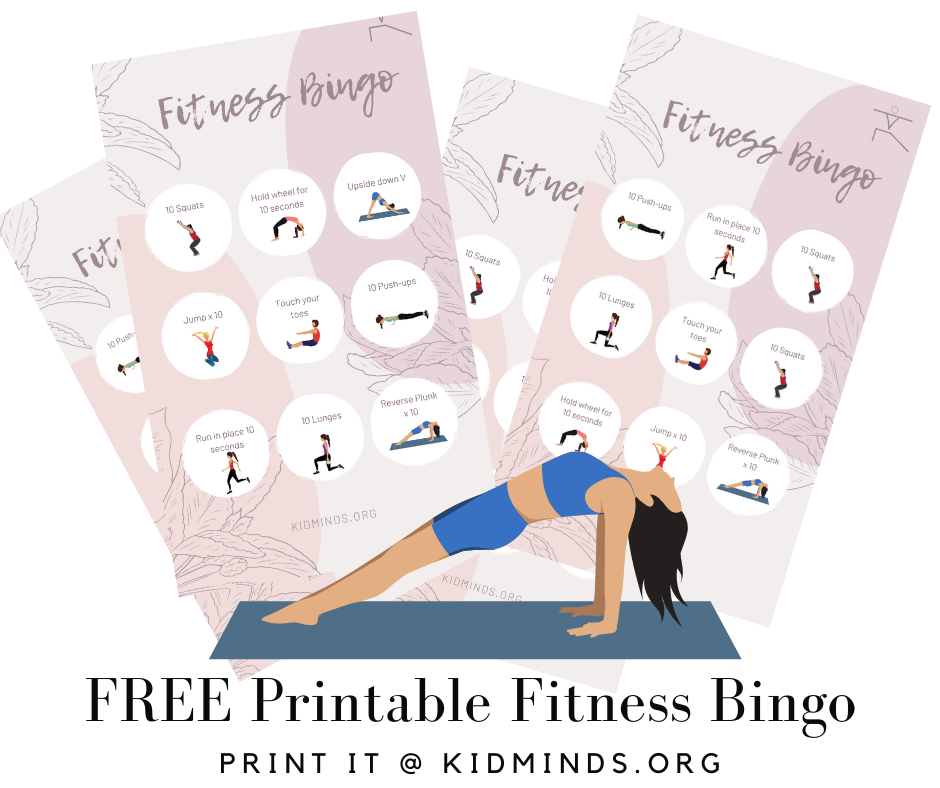
26. Bingo
Everybody loves bingo, right? Especially if you play for money, candy, or anything special for your kids, like extra park time or more cuddles before bed. Playing Bingo is not just fun – it’s beneficial for cognitive functioning in multiple ways. It improves the brain’s processing speed, focus, and stimulates memory. On the downside, it’s usually sedentary, so we fixed that…
Download our Fitness Bingo Cards here. Print one card for each child and one for the leader. The leader calls out a move. The players have to do the move and then check their boards. If they have it, cover it with a penny (or a stone, bead, or small toy). The winner must mark a horizontal, vertical, or diagonal line to get BINGO. As a variation, players need to fill the card in the shape of a U (so everything but the two higher moves in the middle row will be covered).
Do you wonder how exactly Bingo improves memory? Scientists tell us that playing bingo improves the way our brain processes information, including the brain’s processing speed, alertness, and memory capacity.
27. Logic Puzzles
There are a million logic puzzles you can buy or look up online. Here’s one you can show your kids just before going for a walk. And encourage them to keep trying to solve it mentally by visualizing and manipulating the coins in their minds while they’re walking.

Point out that the horizontal line has four coins and that the vertical line has three coins. Can your kids move only one coin to form two lines, with each containing three coins? If your child comes back from the walk without a solution, find six coins (of any value), place them as in the pic above, and let them move the coins around. It might help to find a solution!
28. Thinking Skills: Guess the Person
Do you have a funny aunt? A clever neighbor? Or a loud coach? Give your child 3 clues and let them guess the person you have in mind. It can go like this:
Example 1: This person’s hair is not grey. This person’s sneakers are red. This person has a mustache. Who is it?
Example 2: This person owns a cat. This person has a blue shirt. This person had a flat tire in front of our house once.
Example 3: This person’s eyes are not green. This person makes yummy cakes. This person doesn’t have a dog.
The trick, of course, is to hold the clues in mind while sifting through all the people they know. It’s a great car game!

29. Go for a Walk and Make a Map
Visual-spatial memory is a cognitive skill that helps you visualize something and keep it in your mind’s eye as you process the information, problem-solve, and analyze it.
Useful?
You bet!
It’s also what helps you find your way home if your phone battery dies and you can’t bring Google Maps up to help you orient yourself in space.
This is how you do it: Go for a nice relaxing walk, paying attention to how the road forks here and there, what landmarks appear along the way, and how far the distance is (in your estimate). When you get home, bring out a roll of butcher paper (or tape a few A4 pieces together) and engage your spatial thinking.
Start with an X for “I’m here,” and then retrace your steps. Did you go left or right once you walked out of the front door? What did you see on your left and right?
Keep going until you reach the end of your route. The next time you go for a walk, bring your map and compare it to the actual environment. How accurate was your map? Can you make a second (improved) version when you get back this time?
Visual-spatial abilities are essential for doing many everyday tasks. For example, solving complex math problems involves a lot of visualization. Plus, it’s now apparent that visual-spatial memory is even involved in things like reading and writing (i.e., letters are simply shapes that need to be recognized and processed).
30. Remembering Phone Numbers
Do you want to help your child remember your number? Here’s a little game I invented at Starbucks one day to help my daughter.
Place napkins in a row, each with a single digit from your number but in a random order.
Tear a tiny piece of one napkin and write down a reward word on it, for example, cookie or whatever other treat your child likes at Starbucks. Ask your child not to look while you hide the “cookie” under the napkin that corresponds to the first number of your phone.
My number starts with 773, so I start the game by hiding a “cookie” under a napkin that has #7 on it and ask my child to guess where it is. Once you reveal that the “cookie” is under napkin #7, your child writes it down on a separate napkin (or piece of paper).
Keep going until your whole number is written down in front of your child.
Review the whole phone number before going to bed and then again when they wake up the next day.
Final Words
Good memory is essential to any creative effort, intellectual endeavor, and the key to success in just about all areas of our lives. Incorporating these memory games into your routines – especially at moments when you’re usually bored – will benefit both you and your kids for life! Do you have a favorite memory game? Did any of our games catch your attention? Let me know in the comments below!

Leave a Reply